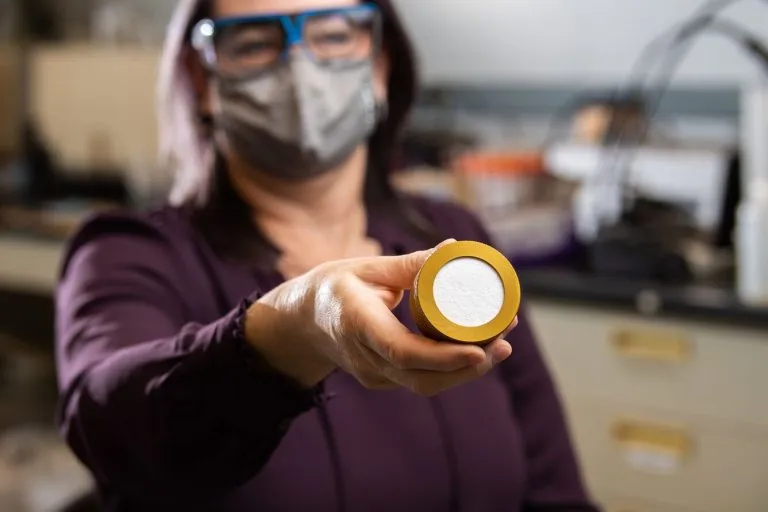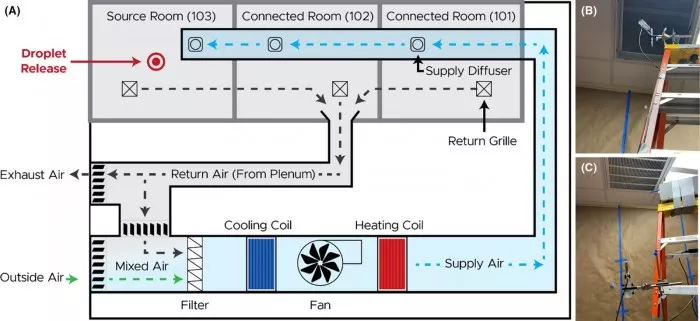A Modeling Study Raises Questions About How Far Respiratory Droplets Can Spread Before They Become Harmless, Such As Those That Spread The Virus That Causes Covid-19 Is It Possible For Airborne Particles Carrying The Virus To Remain Infectious Beyond 200 Feet Or Beyond The Length Of The Hockey Field

Experiments Dating Back To The 1930s Have Shown That Respiratory Droplets, Such As Those Produced By Sneezing Or Coughing, Have Two Ways. Or They Are Big And Heavy, Tumbling To The Ground And Almost Impossible To Infect Another Person. Or They Are Small And Light And Dry Up Almost Immediately, Allowing Them To Remain Airborne, But Quickly Become Harmless. This Drying Can Prevent The Spread Of "envelope" Viruses Such As Coronavirus.
However, A Recent Study By Scientists At The Northwest Pacific National Laboratory (PNNL) Of The U.S. Department Of Energy Provides A Third Possibility: Tiny Respiratory Particles May Remain Wet And Spread In The Air For Longer And Longer Than Previously Thought.
Leonard Pease, Corresponding Author Of The Study, Said: "there Are Reports That People Have Contracted Coronavirus Downwind Of Infected People Or Minutes After The Infected Person Leaves The Room." The Results Were Published In The February Issue Of International Heat And Mass Transfer In The Magazine.

"The View That Envelope Viruses May Maintain A Good Hydration State And Thus Have Complete Infectivity Over A Considerable Distance Is Consistent With Real-world Observations." Pease Added: "maybe Infectious Respiratory Droplets Last Longer Than We Realize."
The PNNL Team Observed For A Long Time The Mucus Surrounding The Respiratory Droplets That People Ejected From Their Lungs. Scientists Know That Mucus Enables Many Viruses To Go Farther Than Others, Enabling Them To Go From One Person To Another.
The Traditional View Is That Very Small Aerosol Droplets Of Only A Few Microns, Like Those Produced In The Lungs, Dry Almost Instantaneously In The Air And Become Harmless. But The PNNL Team Found That Mucus Changed The Equation.
The Team Found That The Mucus Shell Surrounding The Respiratory Droplets May Reduce The Evaporation Rate And Increase The Time For Virus Particles In The Droplets To Remain Wet. Because Envelope Viruses Such As Sars-cov-2 Have A Fat Coating And Must Be Kept Wet To Make The Virus Infectious, The Slow Evaporation Rate Makes The Virus Particles Infectious For A Longer Time.
It Is Estimated That The Group Can Be Wrapped With Mucus For About 200 Feet And Can Be Kept Moist For About 30 Minutes.
"Although Many Factors Have Been Proposed As Variables In The Mode Of Covid Transmission, Mucus Is Still Largely Ignored," Pease Said
The Authors Of The Paper Include Pease And Nora Wang Esram, Gourihar Kulkarni, Julia Flaherty And Carolyn Burns.

The Focus On Mucus Helps Solve Another Problem: How Viruses Move In Multi Room Office Buildings.
Hitchhiking In Respiratory Droplets Is The First Step For The Virus To Become An Airborne Carrier And Infect Inhalers. The Task Of Chemist Carolyn Burns Is To Make Artificial Droplets Similar To Respirators To Study How Particles Move Between Rooms.
Finally, Burns Identified Two Substances To Carry Artificial Virus Like Particles. One Is Cow Mucus; The Other Is Sodium Alginate, A Compound Extracted From Brown Algae. This Compound Is Often Used As A Thickener In Foods Such As Ice Cream And Cheese.
The Team Used Jets To Disperse Droplets In A Room In A Multi Room Experimental Building. The Droplets, Together With An Air Gun, Simulate A Person's Cough, Releasing Particles In A Source Chamber For About A Minute. A Team Led By Alex Vlachokostas And Burns Measured Droplet Levels In Two Adjacent Rooms And Controlled Building Ventilation.
The Team's Experimental Results Were Published In [indoor Air] On January 19, 2022( Https://onlinelibrary.wiley.com/doi/10.1111/ina.12940 ) 》In The Journal, It Echoes The Results Of Its Previous Modeling Research Published In The Journal Of Architecture And Environment Last Year.
Scientists Have Found That Both Low And High Levels Of Filtration Can Effectively Reduce Respiratory Droplet Levels In All Rooms. The Level Of Droplets In The Adjacent Room Decreased Rapidly By About A Third Or Less In The Next Hour.
The Team Also Found That Increasing The Amount Of Ventilation Can Quickly Reduce The Level Of Particulate Matter In The Source Room. However, The Level Of Particulate Matter In Other Adjacent Rooms Jumped Immediately; After 20 To 45 Minutes, The Particulate Matter Level Surged With Vigorous Ventilation. Finally, After The Initial Surge, Droplet Levels In All Rooms Gradually Decreased After 3 Hours With Filtration And 5 Hours Without Filtration.
Scientists Say That Increasing Air Exchange In Crowded Spaces May Be Beneficial In Some Cases, Such As Large Conferences Or School Gatherings, But Under Normal Working And School Conditions, It May Actually Increase The Transmission Rate Of All Rooms In The Whole Building.
"If You're In A Downstream Room And You're Not The Source Of The Virus, You May Not Get Better With More Ventilation," Pease Said
The Authors Of Indoor Air Papers Include Burns, Vlachokostas And Pease, As Well As Timothy Salsbury, Richard C. Daniel, Daniel P. James, Julia E. Flaherty, Nora Wang Esram, Ronald M. Underhill And Gourihar Kulkarni.
These Two Projects Are Funded Through The National Virtual Biotechnology Laboratory, Which Is A Consortium Of All 17 National Laboratories Of The U.S. Department Of Energy And Focuses On Coping With Covid-19. The Funds Are Provided By The Novel Coronavirus Assistance, Relief And Economic Security Act (cares Act). These Projects Are One Of Several PNNL Studies Designed To Learn More About Sars-cov-2 Virus And Covid-19.

